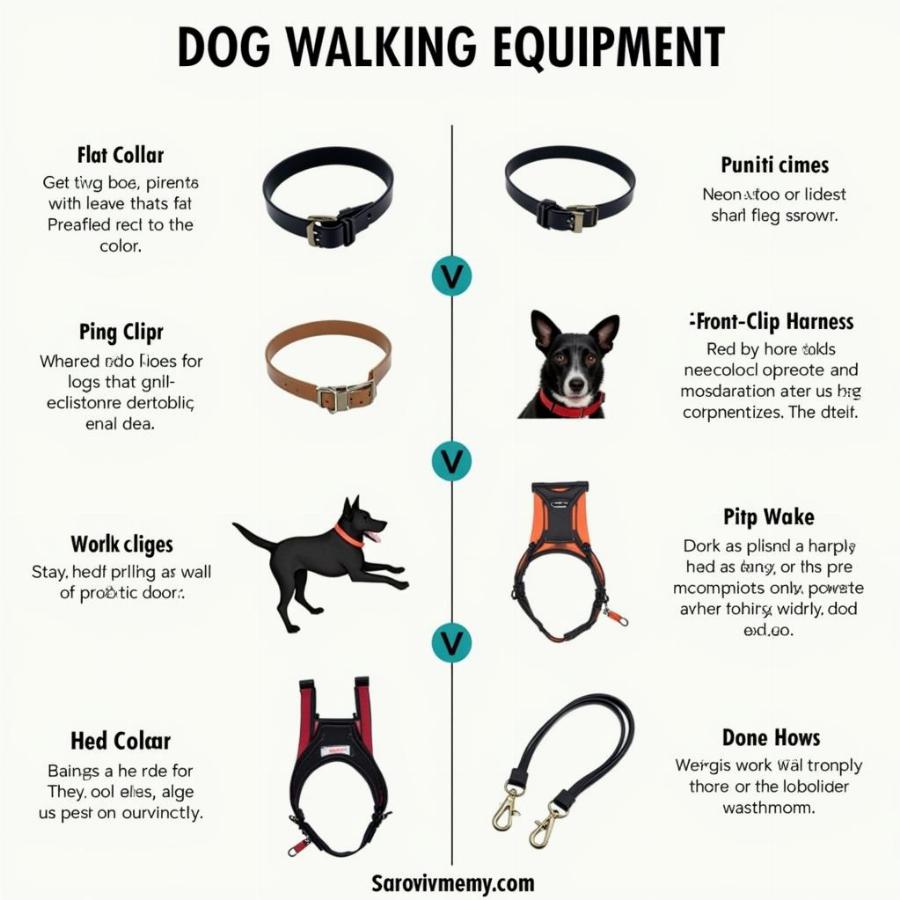Prong collars, also known as pinch collars, are a type of dog collar with metal prongs that distribute pressure around the dog’s neck when pulled. While often touted for their effectiveness in controlling strong or reactive dogs, prong collars have become a controversial topic among dog owners and trainers. This article will delve into the uses, safety concerns, and humane alternatives to prong collars for dogs.
How Prong Collars Work
Prong collars work on the principle of aversive training, using discomfort or pain to discourage unwanted behaviors. When a dog pulls on the leash, the prongs press into the skin around the neck, creating a pinching sensation. This discomfort is intended to teach the dog to avoid pulling.
The Controversy Surrounding Prong Collars
While proponents argue that prong collars can be effective tools for training certain dogs, opponents cite concerns about potential physical and psychological harm.
Physical Risks:
- Neck Injuries: Improper use or a poorly fitted prong collar can lead to injuries to the trachea, esophagus, and nerves in the neck.
- Skin Irritation: The prongs can cause skin abrasions, punctures, and irritation, especially with prolonged use.
- Eye Injuries: Sudden jerks on a prong collar can cause whiplash, potentially leading to eye injuries.
Psychological Effects:
- Fear and Anxiety: The use of pain or discomfort can create fear and anxiety in dogs, potentially worsening behavioral issues.
- Aggression: Some dogs may react aggressively when experiencing pain or discomfort from a prong collar.
- Damaged Bond: Aversive training methods can damage the trust and bond between a dog and their owner.
Are Prong Collars Ever Justified?
While many trainers and veterinary professionals advise against using prong collars, some argue that there are limited situations where they might be considered a last resort. These situations typically involve dogs that pose a significant safety risk due to extreme pulling or aggression, and only after other training methods have been exhausted.
Important Note: The decision to use a prong collar should always be made in consultation with a certified professional dog trainer or veterinary behaviorist. They can assess the individual dog’s needs and guide owners on proper fitting and usage if deemed absolutely necessary.
Humane Alternatives to Prong Collars
Fortunately, there are numerous humane and effective alternatives to prong collars that focus on positive reinforcement and teaching desirable behaviors:
1. Harnesses:
Harnesses distribute pressure more evenly across the dog’s body, reducing the risk of neck injuries.
- Front-Clip Harnesses: These harnesses discourage pulling by gently steering the dog to the side when they pull.
prong collar for dogs - Back-Clip Harnesses: Suitable for dogs who walk calmly on a leash, providing comfort and control.
2. Head Collars:
Head collars work similarly to a horse halter, gently redirecting the dog’s head and therefore their body.
3. Positive Reinforcement Training:
Rewarding desired behaviors with treats, praise, or toys is highly effective in teaching dogs to walk politely on a leash.
4. Seek Professional Help:
If you’re struggling to manage your dog’s pulling or behavioral issues, don’t hesitate to seek professional help from a certified dog trainer or behaviorist.
“Prong collars should only ever be used as a last resort, and only under the guidance of a qualified professional,” advises Sarah Williams, a certified dog trainer with over 15 years of experience. “There are so many effective and humane training methods available today that prioritize the dog’s well-being.”
Choosing the Right Equipment for Your Dog
Selecting the appropriate walking equipment for your dog depends on various factors, including their size, temperament, and training needs.
Consider these factors:
- Size and Breed: Choose a harness or collar that fits your dog comfortably and securely.
- Pulling Strength: For strong pullers, opt for front-clip harnesses or consider a head collar.
- Temperament: If your dog is reactive or anxious, avoid aversive tools that could worsen their anxiety.
- Training Goals: Choose equipment that aligns with your training goals and methods.
 Dog Walking Equipment Comparison
Dog Walking Equipment Comparison
Conclusion
While prong collars might seem like a quick fix for leash pulling, they come with potential risks that shouldn’t be taken lightly. By focusing on positive reinforcement, humane training methods, and seeking professional guidance when needed, you can build a strong bond with your dog while ensuring their physical and emotional well-being. Remember, a walk with your furry friend should be an enjoyable experience for both of you.
FAQs about Prong Collars for Dogs
1. Are prong collars illegal?
The legality of prong collars varies depending on your location. Some countries and regions have banned or restricted their use. It’s crucial to research and understand the laws in your area.
2. Can I use a prong collar on a puppy?
Prong collars should never be used on puppies or young dogs, as their necks and bones are still developing.
3. Do prong collars stop pulling instantly?
While some dogs may stop pulling immediately due to the discomfort, prong collars don’t address the underlying reasons for pulling.
4. What should I do if my dog reacts aggressively to a prong collar?
Immediately stop using the collar and consult with a certified dog trainer or veterinary behaviorist.
5. Are there any side effects of using a prong collar long-term?
Prolonged use of prong collars can lead to chronic pain, behavioral issues, and physical injuries.
Looking for more information about dog collars and harnesses? Check out these helpful resources:
Beaut Dogs is your go-to source for all things dog-related. We’re committed to providing dog owners with reliable information and resources to ensure the happiness and well-being of their furry companions. For personalized advice or assistance in finding the right training tools, feel free to reach out to us at [email protected].